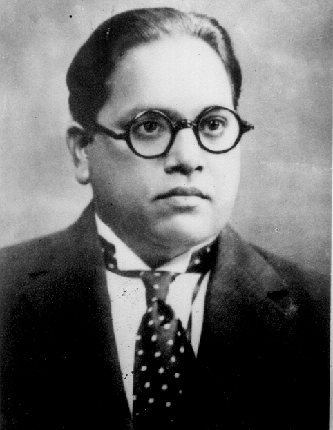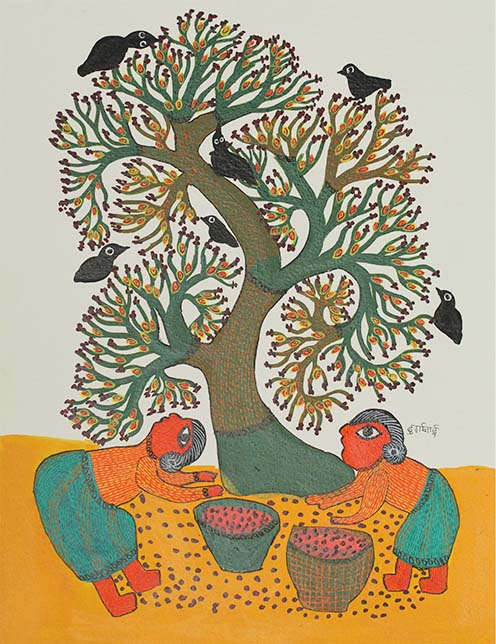|
Bhimayana
''Bhimayana: Incidents in the Life of Bhimrao Ramji Ambedkar'' is a graphic biography of Bhimrao Ramji Ambedkar published in 2011 by Navayana and was hailed by CNN as being among the top five political comic books. It was created by artists Durgabai Vyam, Subhash Vyam and writers Srividya Natarajan and S. Anand. It depicts the experiences of caste discrimination and resistance that Bhimrao Ambedkar recorded in his autobiographical illustrations, later compiled and edited in ''Babasaheb Ambedkar: Writings and Speeches'' by Vasant Moon under the title “Waiting for a Visa”. It is one of India's top selling graphic books. Bhimayana has been lauded for its use of Pardhan Gond art to signify the experiences of social discrimination faced by Ambedkar. It uses digna (images originally painted on the walls and floors of Pardhan Gonds’ houses) patterns and nature imagery. These paintings have been done traditionally by Gond people. Digna paintings have been brought to the notice of ... [...More Info...] [...Related Items...] OR: [Wikipedia] [Google] [Baidu] |
Bhimrao Ramji Ambedkar
Bhimrao Ramji Ambedkar (14 April 1891 – 6 December 1956) was an Indian jurist, economist, social reformer and political leader who headed the committee drafting the Constitution of India from the Constituent Assembly debates, served as Law and Justice minister in the first cabinet of Jawaharlal Nehru, and inspired the Dalit Buddhist movement after renouncing Hinduism. Ambedkar graduated from Elphinstone College, University of Bombay, and studied economics at Columbia University and the London School of Economics, receiving doctorates in 1927 and 1923 respectively and was among a handful of Indian students to have done so at either institution in the 1920s. He also trained in the law at Gray's Inn, London. In his early career, he was an economist, professor, and lawyer. His later life was marked by his political activities; he became involved in campaigning and negotiations for India's independence, publishing journals, advocating political rights and social freedo ... [...More Info...] [...Related Items...] OR: [Wikipedia] [Google] [Baidu] |
Durgabai Vyam
Durga Bai Vyam (born in 1973) is an Indian artist. She is one of the foremost female artists based in Bhopal working in the Gond tradition of Tribal Art. Most of Durga's work is rooted in her birthplace, Barbaspur, a village in the Mandla district of Madhya Pradesh. She has created paintings for several publications and exhibited her works widely. In 2022, she was awarded Padma Shri by the Government of India for her contributions in the field of arts. Early life Durgabai Vyam was born in Burbaspur, a village in Madhya Pradesh. At the age of six, she learned the art of ''digna'' from her mother, a ritual of painting geometric patterns on the inner and outer walls and floors of the house during weddings and harvest festivals. Her early ''digna'' works were well appreciated by people in the community. Career Listening to stories with her grandmother and mentoring under her mother contributed significantly to Durgabai's art in the initial years. Durgabai Vyam began her crea ... [...More Info...] [...Related Items...] OR: [Wikipedia] [Google] [Baidu] |
Jangarh Singh Shyam
Jangarh Singh Shyam (1962–2001) was a pioneering contemporary Indian artist credited with being the creator of a new school of Indian art called ''Jangarh Kalam''. His work has been exhibited widely the world over including Bhopal, Delhi, Tokyo and New York. His most notable exhibitions include the Magiciens de la terre in Paris (1989) and Other Masters curated by Jyotindra Jain at the Crafts Museum, New Delhi (1998). His 1988 piece ''Landscape with Spider'' sold for $31,250 at Sotheby's, New York, in 2010—a first for an adivasi artist. Jangarh had also painted the interiors of the Legislative Assembly of Madhya Pradesh, the Vidhan Bhavan, and the dome of Bhopal's Bharat Bhavan—one of the most prestigious museums of tribal and contemporary Indian art. He was among the first Gond artists to use paper and canvas for his paintings, thereby inaugurating what is now known as ''Jangarh Kalam''. Biography Jangarh was born into a Pardhan Gond family in the village of Patangar ... [...More Info...] [...Related Items...] OR: [Wikipedia] [Google] [Baidu] |
Navayana (publishing House)
Navayana is an independent anti-caste Indian publishing house based in New Delhi, strongly influenced by Ambedkarite ideas. It was founded by S. Anand and D. Ravikumar in 2003. The first book it published was ''Ambedkar: Autobiographical Notes'' priced at Rs 40 (about $1 at that time). Since then it has published acclaimed fiction, non-fiction, graphic novels and poetry anthologies. From 2009 onwards, Navayana broadened its publishing outlook to include social issues other than caste because ‘the struggle against caste cannot happen in isolation from other struggles for justice and equality’ as a statement on the website reads. In Pali, the word "navayana" means "new vehicle". B. R. Ambedkar used the word in 1956 to describe the branch of Buddhism that wouldn't be mired in the Hinayana-Mahayana divide, but would help dalits gain equality in India. The Navayana logo The logo of the publishing house is an ink sketch of two buffaloes kissing. The publisher S. Anand explain ... [...More Info...] [...Related Items...] OR: [Wikipedia] [Google] [Baidu] |
Parsi
Parsis () or Parsees are an ethnoreligious group of the Indian subcontinent adhering to Zoroastrianism. They are descended from Persians who migrated to Medieval India during and after the Arab conquest of Iran (part of the early Muslim conquests) in order to preserve their Zoroastrian identity. The Parsi people comprise the older of the Indian subcontinent's two Zoroastrian communities vis-à-vis the Iranis, whose ancestors migrated to British-ruled India from Qajar-era Iran. According to a 16th-century Parsi epic, ''Qissa-i Sanjan'', Zoroastrian Persians continued to migrate to the Indian subcontinent from Greater Iran in between the 8th and 10th centuries, and ultimately settled in present-day Gujarat after being granted refuge by a local Hindu king. Prior to the 7th-century fall of the Sassanid Empire to the Rashidun Caliphate, the Iranian mainland (historically known as 'Persia') had a Zoroastrian majority, and Zoroastrianism had served as the Iranian state religion ... [...More Info...] [...Related Items...] OR: [Wikipedia] [Google] [Baidu] |
Indian Graphic Novels
Indian or Indians may refer to: Peoples South Asia * Indian people, people of Indian nationality, or people who have an Indian ancestor ** Non-resident Indian, a citizen of India who has temporarily emigrated to another country * South Asian ethnic groups, referring to people of the Indian subcontinent, as well as the greater South Asia region prior to the 1947 partition of India * Anglo-Indians, people with mixed Indian and British ancestry, or people of British descent born or living in the Indian subcontinent * East Indians, a Christian community in India Europe * British Indians, British people of Indian origin The Americas * Indo-Canadians, Canadian people of Indian origin * Indian Americans, American people of Indian origin * Indigenous peoples of the Americas, the pre-Columbian inhabitants of the Americas and their descendants ** Plains Indians, the common name for the Native Americans who lived on the Great Plains of North America ** Native Americans in ... [...More Info...] [...Related Items...] OR: [Wikipedia] [Google] [Baidu] |
Cultural Depictions Of B
Culture () is an umbrella term which encompasses the social behavior, institutions, and norms found in human societies, as well as the knowledge, beliefs, arts, laws, customs, capabilities, and habits of the individuals in these groups.Tylor, Edward. (1871). Primitive Culture. Vol 1. New York: J.P. Putnam's Son Culture is often originated from or attributed to a specific region or location. Humans acquire culture through the learning processes of enculturation and socialization, which is shown by the diversity of cultures across societies. A cultural norm codifies acceptable conduct in society; it serves as a guideline for behavior, dress, language, and demeanor in a situation, which serves as a template for expectations in a social group. Accepting only a monoculture in a social group can bear risks, just as a single species can wither in the face of environmental change, for lack of functional responses to the change. Thus in military culture, valor is counted a typical be ... [...More Info...] [...Related Items...] OR: [Wikipedia] [Google] [Baidu] |
The Comics Journal
''The Comics Journal'', often abbreviated ''TCJ'', is an American magazine of news and criticism pertaining to comic books, comic strips and graphic novels. Known for its lengthy interviews with comic creators, pointed editorials and scathing reviews of the products of the mainstream comics industry, the magazine promotes the view that comics are a fine art, meriting broader cultural respect, and thus should be evaluated with higher critical standards. History In 1976, Gary Groth and Michael Catron acquired ''The Nostalgia Journal'', a small competitor of the newspaper adzine '' The Buyer's Guide for Comics Fandom''. At the time, Groth and Catron were already publishing ''Sounds Fine'', a similarly formatted adzine for record collectors that they had started after producing Rock 'N Roll Expo '75, held during the July 4 weekend in 1975 in Washington, D.C. The publication was relaunched as ''The New Nostalgia Journal'' with issue No. 27 (July 1976), and with issue No. 32 (Janua ... [...More Info...] [...Related Items...] OR: [Wikipedia] [Google] [Baidu] |
Amitava Kumar
Amitava Kumar (born 17 March 1963) is an Indian writer and journalist who is Professor of English on the Helen D. Lockwood Chair at Vassar College. Early life Kumar was born in the city of Arrah in the Indian state of Bihar on 17 March 1963. He grew up close to his birthplace in Patna, also in Bihar. There he spent his formative years at St. Michael's High School, Patna, St Michael's High School. In India, Kumar earned a bachelor's degree in political science from Hindu College, University of Delhi, Hindu College, Delhi University in 1984. He holds two master's degrees in Linguistics and Literature from Delhi University (1986) and Syracuse University (1988) respectively. In 1993, he received his doctoral degree from the Department of Cultural Studies and Comparative Literature at the University of Minnesota. He lives with his family in Poughkeepsie, New York, Poughkeepsie, New York. Work Overview Kumar is the author of ''Husband of a Fanatic'' (The New Press, 2005 and Penguin-I ... [...More Info...] [...Related Items...] OR: [Wikipedia] [Google] [Baidu] |
Paul Gravett
Paul Gravett is a London-based journalist, curator, writer, and broadcaster who has worked in comics publishing since 1981. He is the founder of ''Escape Magazine'', and for many years wrote a monthly article on comics appearing in the UK magazine '' Comics International'', together with a monthly column for ''ArtReview''. He has written for various periodicals including ''The Guardian'', ''The Comics Journal'', ''Comic Art'', ''Comics International'', ''Time Out'', ''Blueprint'', ''Neo'', ''The Bookseller'', ''The Daily Telegraph,'' and '' Dazed & Confused''. Biography His career began in 1981, as he managed the Fast Fiction table at bi-monthly Comic Marts held in Westminster Hall. Gravett invited artists to send him their homemade comics, which he would sell from the Fast Fiction table with all proceeds going to the creator. His role in the British indie comics scene is depicted in Eddie Campbell's '' Alec'' comics, in which Gravett is called "The Man at the Crossroads." Late ... [...More Info...] [...Related Items...] OR: [Wikipedia] [Google] [Baidu] |
Anthropomorphism
Anthropomorphism is the attribution of human traits, emotions, or intentions to non-human entities. It is considered to be an innate tendency of human psychology. Personification is the related attribution of human form and characteristics to abstract concepts such as nations, emotions, and natural forces, such as seasons and weather. Both have ancient roots as storytelling and artistic devices, and most cultures have traditional fables with anthropomorphized animals as characters. People have also routinely attributed human emotions and behavioral traits to wild as well as domesticated animals. Etymology Anthropomorphism and anthropomorphization derive from the verb form ''anthropomorphize'', itself derived from the Greek ''ánthrōpos'' (, "human") and ''morphē'' (, "form"). It is first attested in 1753, originally in reference to the heresy of applying a human form to the Christian God.''Oxford English Dictionary'', 1st ed. "anthropomorphism, ''n.''" Oxford University P ... [...More Info...] [...Related Items...] OR: [Wikipedia] [Google] [Baidu] |





